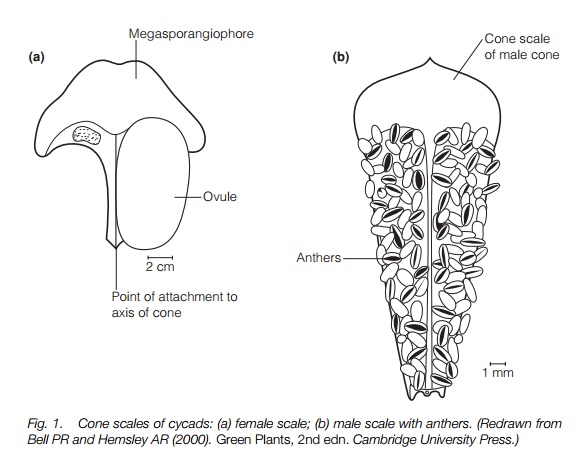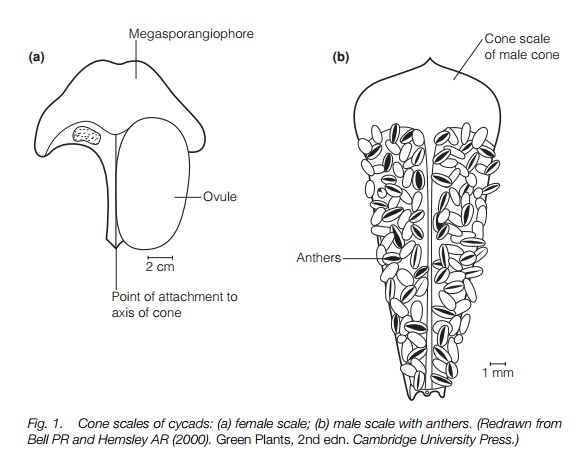Chapter: Plant Biology : Seed plants
Cycads and Reproduction in cycads

CYCADS
Key Notes
Cycads
There are about 76 species of cycads of the tropics and subtropics, the nearest living relatives of the pteridosperms. They have stout trunks with a pith and little secondary thickening, usually unbranched, and long pinnate leaves, interspersed with scale leaves.
Reproduction in cycads
All are dioecious, bearing either male or female fertile leaves, usually in cones. The sporangia are in pairs or groups. Pollen grains have three cells when released and produce two enormous flagellate sperm after they have reached the pollination drop by the ovules. The female gametophyte has many cells and archegonia. Fertilization can take 5 months from pollination.
Cycads
The cycads, Cycadales, are a group of palm-like plants that are the nearest living relatives to the pteridosperms. Their current distribution ranges from southern North America to Chile (about 36 species), South Africa (15 spp.) and eastern Asia to Australia (25 spp.), but fossils are much more widespread, and between the Triassic and Cretaceous periods they were more abundant and varied. All are woody, slow-growing plants with large pinnate leaves in a cluster at the tip, occupying understorey positions in plant communities, though common in places. The trunks are thick, normally unbranched, and typically to about 2 m tall, though a few grow to 15 m and a few have branched horizontal stems with leaf rosettes at ground level. They have a large central pith, restricted secondary thickening and a cortex. Scale leaves occur interspersed with the foliage leaves and can cover part of the trunk. Age can be inferred from the leaf scars and they can live to 1000 years or more. They have a deep tap root and surface roots often associating with cyanobacteria and fungi which probably aid in nutrition (Topics M1 and M2). The starchy central pith is eaten in some places as sago (the main sago plants are palms) and some species are grown as ornamentals.
Reproduction in cycads
All cycads are dioecious and most produce reproductive structures on specialized leaves in terminal or lateral cones (Fig. 1). These cones can be enormous, weighing up to 40 kg. The anthers are borne on the underside of thick, scale-like leaves. The male gametophyte grows first within the wall of the pollen grain. The pollen is released when the gametophyte has three cells. The pollen grain bursts once it has reached a drop of fluid by the micropyle of an ovule, and the cells divide to give rise to two or more sperms (one genus, Microcycas, has up to 16 sperms). The sperms are like those of ferns in that they have numerous flagella and swim actively to fertilize the ovules, but they are about 1000 times the size of fern sperms.

The ovules vary from 6 mm to 6 cm in diameter and are borne in pairs, or as six or eight together, on large scale-leaves. The female gametophyte, developing entirely within the ovule wall, first has free nuclear divisions and later forms cell walls when there are 1000 or more nuclei. Archegonia are formed by the micropyle with a single ventral canal cell above an egg that is the largest among land plants, up to 3 mm in diameter. A pollination drop is secreted by the micropyle containing sugars and amino acids, and the pollen is trapped in this. Some cycads are pollinated by insects, mainly weevils, so the drop is an attractant as well as a pollen trap; others may be wind-pollinated. The whole process of fertilization in cycads takes about 5 months. Once fertilized, the ovule grows quickly, again with a period of free nuclear divisions first, absorbing the female gametophyte tissue. One, two or three cotyledons are formed and the seed germinates as soon as there are favorable conditions.
Related Topics